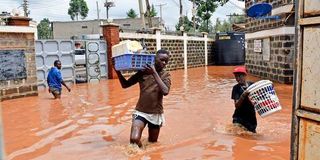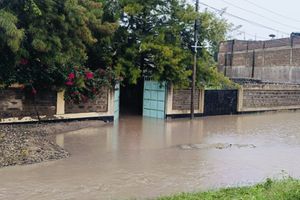
Residents of Supa Care apartment block in Ruaka area salvage some of their belongings on April 23, 2024 after their houses were flooded as a result of heavy rains.
The state failed to put in place mitigating measures to avert flooding in the country and minimise loss of lives and properties, an audit report has shown.
According to a report by the Auditor-General Nancy Gathungu tabled in the National Assembly, the government failed to undertake the required measures to deal with floods.
Ms Gathungu, in a performance audit report on the response to floods in Kenya in March 2023, shows how the lack of a clear disaster response legal framework and policies may have aggravated the current flooding situation in the country.
The audit reveals that some of the victims of the 2020 floods were still in camps in Baringo, Kisumu and Busia counties.
Although a majority of the victims had gone back to their homes, they were not able to rebuild their houses and were living in tents.
This comes even as the current flooding situation in the country due to heavy rains continues to cause havoc, with the death toll from the floods menace over 200, with thousands displaced after their homes were submerged.
The audit, which covered five years from July 2017 to June 2022, focused on the State Department for Internal Security and National Administration operations through the National Disaster Operations Centre and the Directorate of Special Programmes.
The operations of the two government agencies were examined by the auditors in terms of preparedness measures in place for response, evacuation of victims, relief processes, recovery after flooding and coordination of actors.
The audit sampled six counties spread across the flood-prone areas - Baringo, Narok, Busia, Garissa, Tana River and Kisumu, making specific recommendations to the government on how to deal with future occurrences.
“The State department for Internal Security and National Administration should coordinate with the Special Programmes to develop the national disaster risk management policy and law enacted,” the performance audit recommends.
“This will not only address the institutional capacity challenges facing flood response operations but also resolve the challenges faced in mandates and coordination.”
The audit of government response to floods was necessary to establish the measures put in place by the government to respond to flood-related disasters to ensure minimal losses and effective and fast recovery after flooding.
The audit revealed that despite floods in the country being cyclical and occurring annually, there was no specific budget line for food response from the government agencies.
The State Department for Internal Security is responsible for disseminating flooding warning information and coordination responses, managed through the National Disaster Operations Centre (NDOC) and National Government Administration Officers (NGAO).
The Directorate of Special Programmes, domiciled in the State Department for Arid and Semi-Arid Lands (ASALs) and Regional Development, is responsible for humanitarian relief and rehabilitation of flood victims.
“The audit revealed that the government response to floods was characterised by inadequacies and deficiencies in response and recovery. This was attributed to challenges in governance and preparedness by the agencies entrusted with the role,” the audit says.
This means that had the government implemented the recommendations of the audit, the response to the current flooding situation may have salvaged the situation.
In helping to address future flooding disasters, the Special Programmes was to finalise the development of the National Relief Assistance Policy and follow through to enact the applicable law.
“This will resolve the inefficiencies observed in relief processes by providing clear and legally binding guidance,” the audit says.
However, the audit revealed that the country did not have a specific legal framework or law on flood management and instead relied on available Disaster Risk Management (DRM) guidance.
A review of documents by the auditors revealed that the development of a national policy on DRM commenced in 2002, but the policy was still in draft form at the time of the audit.
“The version of the policy approved by the Cabinet in 2017 was not subjected to Parliament for enactment and was under review at the time of the audit,” the audit says.
"Used effectively, the laws and policies can support an integrated, inclusive and equitable approach to flood response and recovery.”
The audit states that attempts to enact a national law on DRM commenced in 2018, but no law was finalized at the time of the audit.
The NDOC issued county governments a template, which they expected to develop a county-level DRM legal framework.
However, out of the six counties sampled for audit, only Tana River County had developed a DRM law and policy.
Baringo County had a policy but was yet to finalize the law.
Kisumu and Busia counties had enacted DRM laws but had not developed their respective DRM policies.
The disaster legal framework assists in clarifying the roles, responsibilities and coordination mechanisms for DRM across sectors as well as between the national and county levels of government.
“The observed challenges facing flood response and recovery outlined in this report can be attributed to lack of legal framework, which not only resulted in unclear mandates, but also contributed to challenges in coordination of actors.”
Interviews with NDOC revealed different entities had vested interests in the enactment of a Disaster Risk Management (DRM) policy and law at the national level.
According to NDOC management, some entities believe a national-level DRM law and policy may lead to consolidation of DRM functions under one entity, denying them access to DRM funds in the future.
The auditors established that other than providing counties with a template for the development of a DRM law, NDOC did not follow up with the counties to ensure that they enacted and implemented DRM laws.
NDOC management reported that similar observations were made by the World Bank.
The audit reveals that the inadequate coordination of flood response activities gives room for interference with response activities and results in an uncoordinated response characterized by duplication of efforts or delayed response.
For instance, documents and interviews revealed interference during relief requests and distribution to the victims.
The audit noted that while early warnings are often communicated, advising people to move to higher grounds, information on places where the community can move to is only done after the actual occurrence of flooding.
Similarly, interviews with county commissioners and NDOC revealed that stakeholders only took coordination meetings seriously after news of flood occurrence was aired in the media.
The audit revealed that none of the six sampled counties had mapped evacuation routes.
It was reported during interviews with sampled county commissioners and officials from county governments that the community often used their knowledge of the area terrain to decide on the routes to follow during evacuations.
Of the six counties sampled, only Kisumu had designated evacuation centres.
However, a review of documents revealed that the six designated evacuation centres in Kisumu were dilapidated, as confirmed through physical inspection.
For instance, the Kamaga evacuation camp needed repairs as it had one ablution block with two toilets.
“The toilets were filled up and sunken thereby posing public health risks.”
Audit documents revealed that the evacuation centres were constructed by the Japan International Cooperation Agency (JICA) in 2009 and handed over to the community, but no maintenance works have been done since.
With no designated centres, the audit revealed that the affected persons sought temporary shelter in schools, churches, social halls and raised open grounds.
Interviews and physical verifications revealed that facilities in schools were often damaged, but the institutions were not assisted in repairing their facilities after the flood victims vacated.
For instance, physical verifications undertaken by the auditors at Ombaka Primary School in Nyando sub-county, which housed the 2020 flood victims, revealed that the classrooms had completely damaged floors and ablution blocks destroyed, filled up and sinking.
“The school administration reported that despite the level of damage, the school had not received any funds to aid in repairs.”
The audit attributed the challenges facing the evacuation of victims to the lack of clarity on the mandate between the national and county governments. Disaster management is a shared function.
However, it remains unclear how evacuation roles should be shared between the two levels of government.
“Evacuation was affected by the ineffective coordination and support to the communities.”
The audit revealed limited recovery interventions towards communities and critical infrastructure.
“Recovery in flood management entails enabling people to return their livelihoods to normalcy and setting up systems to ensure resilience to floods in the future,” says the audit.
The audit advised the government to promote the incorporation of DRM into post-disaster recovery and rehabilitation processes and facilitate the link between relief, rehabilitation and development.
The government was required to use opportunities during the recovery phase to develop capacities that reduce disaster risk in the short, medium and long term.
This included the development of measures such as land-use planning, structural standards improvement and sharing of expertise, knowledge, post-disaster reviews and lessons learned and integrated post-disaster reconstruction into the economic and social sustainable development of affected areas.
This was required to apply to temporary settlements for persons displaced by disasters.
The government was also required to consider relocation of public facilities and infrastructures to areas outside the risk range, whenever possible, in the post-disaster reconstruction process, in consultation with the people concerned as appropriate.
Besides repairing damaged public infrastructure, the government did not do much to aid the community in recovery after the floods.
“Focus was only on the reconstruction of cut out roads and damaged bridges, leaving behind other critical infrastructures such as schools, hospitals and market places,” says the audit.
For instance, the audit observed that the 2020 floods in the Nyando sub-county submerged the entire Ogenya village, affecting a dispensary, primary school and market centre.
At the time of the audit, only the primary school had been relocated, while the market centre and dispensary were non-operational.
Similar observations were noted in the Mabinju sub-location in the Bunyala sub-county, which was also affected by the rising water of Lake Victoria in 2020.












